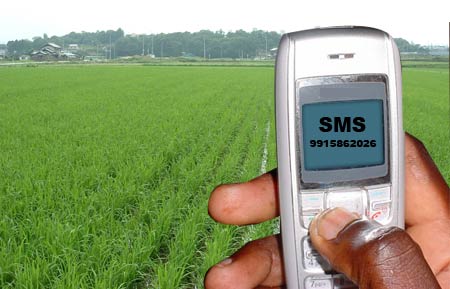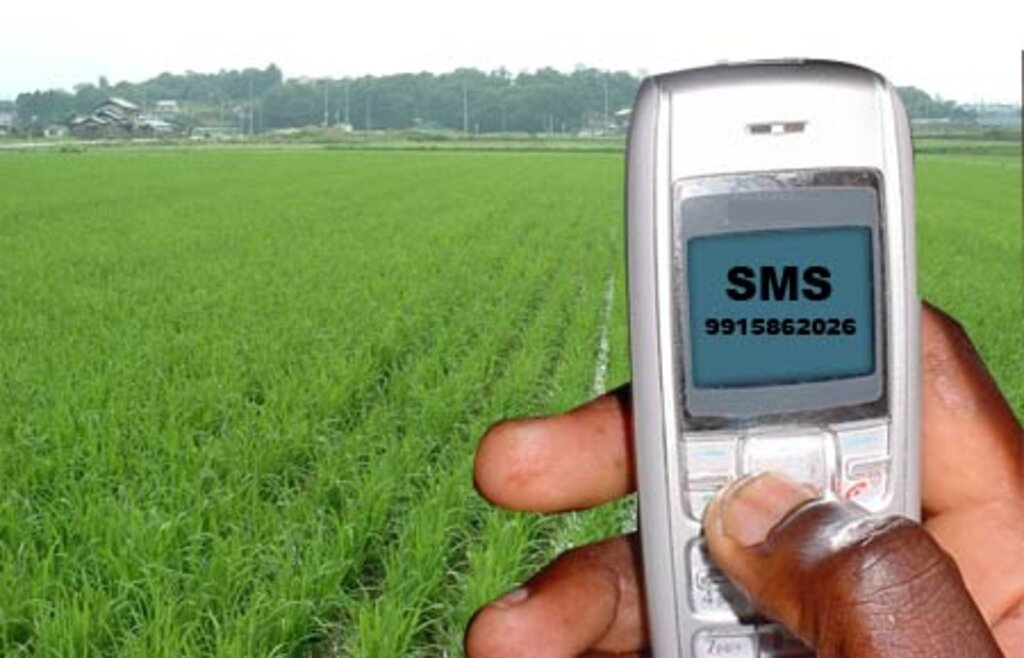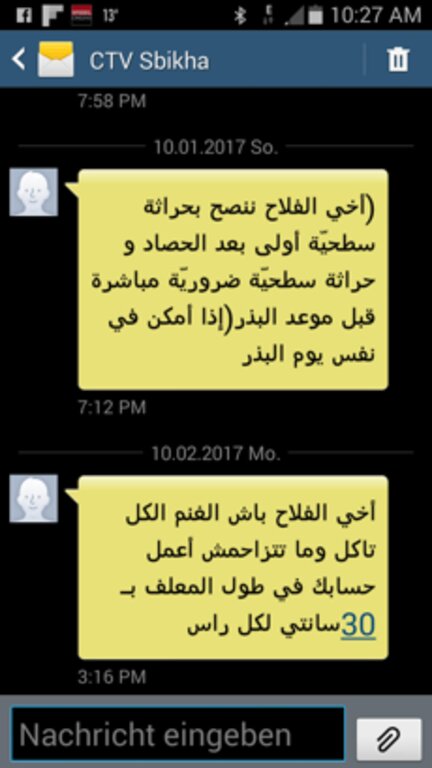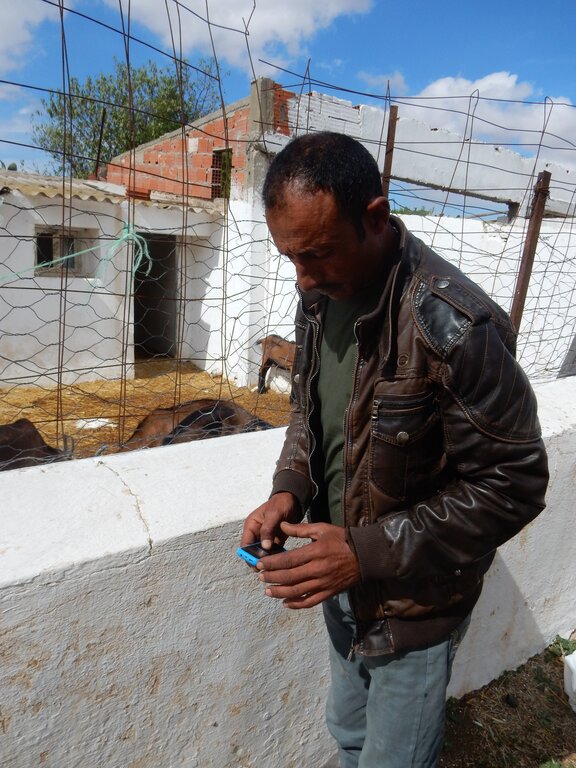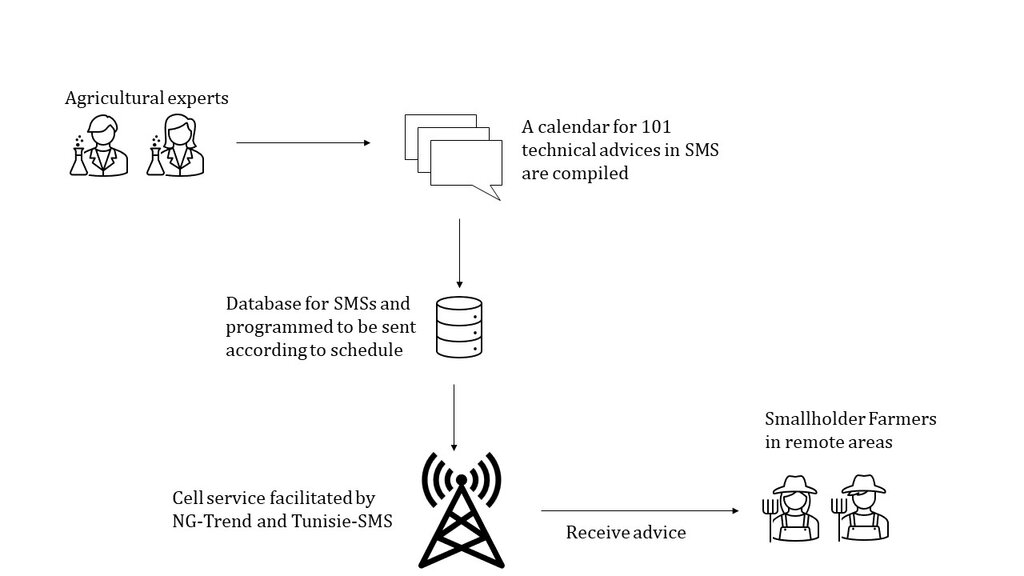ICT2Scale – supporting smallholder farmers with cellphone-based services via SMS [突尼斯]
- 创建:
- 更新:
- 编制者: Joren Verbist
- 编辑者: –
- 审查者: William Critchley, Rima Mekdaschi Studer, Joana Eichenberger
technologies_7002 - 突尼斯
查看章节
全部展开 全部收起1. 一般信息
1.2 参与该技术评估和文件编制的资源人员和机构的联系方式
关键资源人
Agricultural Innovation Specialist:
Rudiger Udo
International Center of Agriculture Research in the Dry Areas (ICARDA)
突尼斯
Agricultural Economist:
Frija Aymen
International Center of Agriculture Research in the Dry Areas (ICARDA)
Economics and Participatory Methods:
Idoudi Zied
International Center of Agriculture Research in the Dry Areas (ICARDA)
Agricultural and Resource Economist:
Dhebibi Boubaker
International Center of Agriculture Research in the Dry Areas (ICARDA)
PhD Candidate:
Oueghemmi H
International Center of Agriculture Research in the Dry Areas (ICARDA)
有助于对技术进行记录/评估的项目名称(如相关)
ICARDA Institutional Knowledge Management Initiative有助于对技术进行记录/评估的机构名称(如相关)
International Center for Agricultural Research in the Dry Areas (ICARDA) - 黎巴嫩1.3 关于使用通过WOCAT记录的数据的条件
编制者和关键资源人员接受有关使用通过WOCAT记录数据的条件。:
是
1.4 所述技术的可持续性声明
这里所描述的技术在土地退化方面是否存在问题,导致无法被认为是一种可持续的土地管理技术?:
否
1.5 参考关于SLM方法(使用WOCAT记录的SLM方法)的调查问卷
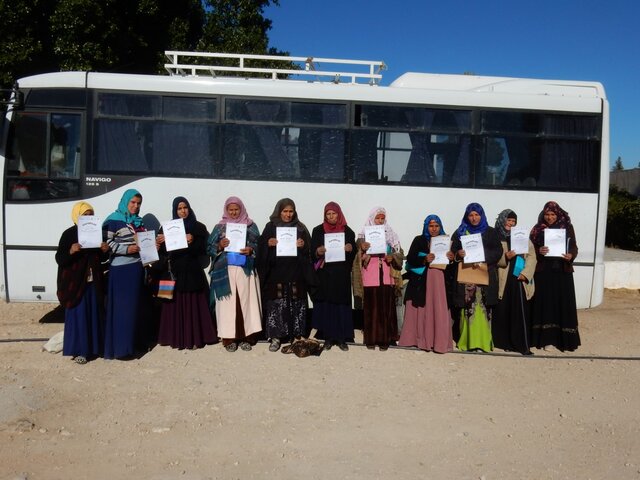
Lessons learned from the "Mind the Gap" project: … [突尼斯]
The “Mind the Gap” project researched the adoption gap between agricultural research and women and men farmers. Its objective was to determine most effective and cost-efficient technology transfer strategies and give recommendations to national extension institutes and development partners to adapt their scaling strategy
- 编制者: Joren Verbist
2. SLM技术的说明
2.1 技术简介
技术定义:
The ICT2Scale project contributes to better land management by supplying smallholder farmers with targeted SMS messages on diverse agricultural practices. This enables them to optimize resources and adopt more sustainable methods, consequently improving livelihoods in remote areas.
2.2 技术的详细说明
说明:
In Tunisia, smallholder farmers rely heavily on extension services for information regarding new and sustainable agricultural practices, improved varieties, and market prices. Unfortunately, these services often fall short, particularly in remote areas, due to inadequate financial, human, and logistical resources. Information and Communication Technologies (ICT) can play a crucial role in filling this void. This can strongly contribute to developing the agricultural sector and reducing or preventing land degradation.
The ICT2Scale project aims to address these issues and reach these substantial group of farmers. The project was led by the International Center of Agricultural Research in Dry Areas (ICARDA). It was initiated in 2019 with a survey to identify the information needs of smallholder farmers. Tunisian farming experts crafted 101 technical SMS messages, disseminating them to approximately 1,000 smallholder farmers in Kairouan, Zaghouan, and Jendouba. These messages covered diverse commodities such as cereals, olives, citrus, honey, and livestock, simultaneously aiding farmers in sustainable land management and resource optimization.
A one-day workshop was organized to compile the advisory messages. Thirty specialists from various disciplines gathered, including different National Agricultural Research and Extension Services (NARES) centres. The workshop's estimated cost (including food and per diem) was around $1000 USD. Each SMS “unit” - of one message to one farmer - costs approximately $0.01 USD, totalling $1010 USD to make the 101 SMS available to 1000 farmers. Although the data services were provided free-of-charge by network companies, the overall project cost is still estimated at $3000 USD per year. Similar infrastructure with similar cost was implemented in the projects “Mind the Gap” and "Crop-Livestock and Conservation Agriculture (CLCA)".
A follow-up survey conducted by phone in May and June 2021 involved 421 SMS recipients, revealed that 60% found the messages useful, with 54% claiming to have learned something new. However, only 15% agreed that the messages arrived at the right time. Notably, 41% of farmers expressed a willingness to pay $0.01 USD per message after the project, indicating a potential avenue for the sustainability of this SMS technology. Farmers recommended using SMS for weather alerts and disease outbreaks; employing phone calls or Interactive Voice Responses (IVR); sending messages at the right time; and incorporating information on marketing, training, and livestock vaccination programmes.
Key advantages of an SMS service are:
-More cost-effective than in-person advice via public extension agents
-Particularly effective during the COVID-19 pandemic due to the lack of personal contact
-Immediate reach to thousands of farmers in case of emergencies or opportunities
-Flexible and adaptable for quick information updates
-Useful when extension resources, such as vehicles and funds, are limited or unavailable
-Effective in disseminating information about events like training and seed distribution
However, some weaknesses persist, including a lack of interaction (i.e. a top-down approach), less convincing than personal exchange, and ongoing funding challenges, with the Tunisian government hesitant to invest in the project without more dialogue and convincing arguments.
In summary, the ICT2Scale project has proved the viability and cost-effectiveness of employing SMS technology to reach smallholder farmers in remote areas. Consequently, this has the potential to enhance more sustainable and efficient use of land and natural resources, leading to an improvement in rural livelihoods. However, securing sustainable funding remains challenging in order to scale up and maximize impact.
Acknowledgement:
ICARDA’s work on Information and Communication Technologies (ICT) for agricultural development is supported by the German Agency for International Development (GIZ) in Collaboration with National Public Partners (AVFA, OEP, INRAT,ONAGRI, and CRDA) and Private Partners (NG Trend, Tunisie SMS) in Tunisia.
2.3 技术照片
2.5 已应用该技术的、本评估所涵盖的国家/地区/地点
国家:
突尼斯
区域/州/省:
Kairouan, Zaghouan, and Jendouba
具体说明该技术的分布:
- 适用于特定场所/集中在较小区域
技术现场是否位于永久保护区?:
否
Map
×2.6 实施日期
注明实施年份:
2019
2.7 技术介绍
详细说明该技术是如何引入的:
- 在实验/研究期间
- 通过项目/外部干预
3. SLM技术的分类
3.1 该技术的主要目的
- 改良生产
- 减少、预防、恢复土地退化
- 降低灾害风险
- 创造有益的经济影响
- 创造有益的社会影响
3.2 应用该技术的当前土地利用类型

农田
- 一年一作
年作 - 具体指明作物:
- 谷类 - 大麦

牧场
粗放式放牧:
- 半游牧畜牧业
动物类型:
- 山羊
- 绵羊
注释:
The SMS messages were directed to different land use and land management such as barley cultivation, livestock herding, and olive production.
3.3 由于技术的实施,土地使用是否发生了变化?
由于技术的实施,土地使用是否发生了变化?:
- 否(继续问题3.4)
3.4 供水
该技术所应用土地的供水:
- 雨养
3.5 该技术所属的SLM组
- 农业林学
- 畜牧业和牧场管理
- 农畜综合管理
- Digital agriculture
3.6 包含该技术的可持续土地管理措施

其它措施
具体说明:
Digital
注释:
Most SMS messages were about agronomic and management measures.
3.7 该技术强调的主要土地退化类型

土壤水蚀
- Wt:表土流失/地表侵蚀

土壤风蚀
- Et:表土流失
- Ed:风蚀风积

化学性土壤退化
- Cn:肥力下降和有机质含量下降(非侵蚀所致)
- Cs:盐化/碱化

生物性退化
- Bc:植被覆盖的减少
- Bq:数量/生物量减少
3.8 防止、减少或恢复土地退化
具体数量名该技术与土地退化有关的目标:
- 防止土地退化
- 减少土地退化
注释:
By informing farmers with technical advice, farmers can manage their land more sustainably.
4. 技术规范、实施活动、投入和成本
4.1 该技术的技术图纸
技术规范(与技术图纸相关):
Agricultural experts from different National Agricultural Research and Extension Services (NARES), lead farmers and ICARDA scientists formulated 101 technical advises in SMS following an elaborated "agricultural" calendar. This way farmers receive technical advice when needed. This is facilitated by NG-Trend and Tunisie-SMS
作者:
Joren Verbist & Udo Rudiger
日期:
2024
4.2 有关投入和成本计算的一般信息
具体说明成本和投入是如何计算的:
- 每个技术单元
指定单位:
Whole project / infrastructure
具体说明成本计算所用货币:
- 美元
4.3 技术建立活动
| 活动 | 时间(季度) | |
|---|---|---|
| 1. | Workshop to compile technical advice | |
| 2. | Setting up network |
4.4 技术建立所需要的费用和投入
| 对投入进行具体说明 | 单位 | 数量 | 单位成本 | 每项投入的总成本 | 土地使用者承担的成本% | |
|---|---|---|---|---|---|---|
| 劳动力 | Workshop to compile 101 SMS advice messages | workshop | 1.0 | 1000.0 | 1000.0 | |
| 设备 | SMS unit (101 SMSs to 1000 farmers) | unit | 101000.0 | 0.01 | 1010.0 | |
| 其它 | Remaining | 1.0 | 1000.0 | 1000.0 | ||
| 技术建立所需总成本 | 3010.0 | |||||
| 技术建立总成本,美元 | 3010.0 | |||||
4.7 影响成本的最重要因素
描述影响成本的最决定性因素:
...
5. 自然和人文环境
5.1 气候
年降雨量
- < 250毫米
- 251-500毫米
- 501-750毫米
- 751-1,000毫米
- 1,001-1,500毫米
- 1,501-2,000毫米
- 2,001-3,000毫米
- 3,001-4,000毫米
- > 4,000毫米
农业气候带
- 半干旱
- 干旱
5.2 地形
平均坡度:
- 水平(0-2%)
- 缓降(3-5%)
- 平缓(6-10%)
- 滚坡(11-15%)
- 崎岖(16-30%)
- 陡峭(31-60%)
- 非常陡峭(>60%)
地形:
- 高原/平原
- 山脊
- 山坡
- 山地斜坡
- 麓坡
- 谷底
垂直分布带:
- 0-100 m a.s.l.
- 101-500 m a.s.l.
- 501-1,000 m a.s.l.
- 1,001-1,500 m a.s.l.
- 1,501-2,000 m a.s.l.
- 2,001-2,500 m a.s.l.
- 2,501-3,000 m a.s.l.
- 3,001-4,000 m a.s.l.
- > 4,000 m a.s.l.
说明该技术是否专门应用于:
- 不相关
5.3 土壤
平均土层深度:
- 非常浅(0-20厘米)
- 浅(21-50厘米)
- 中等深度(51-80厘米)
- 深(81-120厘米)
- 非常深(> 120厘米)
土壤质地(表土):
- 粗粒/轻(砂质)
- 中粒(壤土、粉土)
土壤质地(地表以下> 20厘米):
- 粗粒/轻(砂质)
- 中粒(壤土、粉土)
表土有机质:
- 低(<1%)
5.4 水资源可用性和质量
地下水位表:
5-50米
地表水的可用性:
匮乏/没有
水质(未处理):
仅供农业使用(灌溉)
水质请参考::
地下水
水的盐度有问题吗?:
是
该区域正在发生洪水吗?:
否
5.5 生物多样性
物种多样性:
- 低
栖息地多样性:
- 低
5.6 应用该技术的土地使用者的特征
定栖或游牧:
- 定栖的
生产系统的市场定位:
- 混合(生计/商业)
非农收入:
- 收入的10-50%
相对财富水平:
- 贫瘠
- 平均水平
个人或集体:
- 个人/家庭
- 团体/社区
机械化水平:
- 手工作业
- 机械化/电动
性别:
- 女人
- 男人
土地使用者的年龄:
- 中年人
- 老年人
5.7 应用该技术的土地使用者使用的平均土地面积
- < 0.5 公顷
- 0.5-1 公顷
- 1-2 公顷
- 2-5公顷
- 5-15公顷
- 15-50公顷
- 50-100公顷
- 100-500公顷
- 500-1,000公顷
- 1,000-10,000公顷
- > 10,000公顷
这被认为是小规模、中规模还是大规模的(参照当地实际情况)?:
- 小规模的
5.8 土地所有权、土地使用权和水使用权
土地所有权:
- 个人,未命名
- 个人,有命名
土地使用权:
- 个人
用水权:
- 社区(有组织)
- 个人
土地使用权是否基于传统的法律制度?:
是
5.9 进入服务和基础设施的通道
健康:
- 贫瘠
- 适度的
- 好
教育:
- 贫瘠
- 适度的
- 好
技术援助:
- 贫瘠
- 适度的
- 好
就业(例如非农):
- 贫瘠
- 适度的
- 好
市场:
- 贫瘠
- 适度的
- 好
能源:
- 贫瘠
- 适度的
- 好
道路和交通:
- 贫瘠
- 适度的
- 好
饮用水和卫生设施:
- 贫瘠
- 适度的
- 好
6. 影响和结论性说明
6.1 该技术的现场影响
社会经济效应
生产
作物生产
注释/具体说明:
By informing farmers with technical advise, it is expected that the production increases.
作物质量
注释/具体说明:
By informing farmers with technical advise, it is expected that the quality of production increases.
畜牧生产
注释/具体说明:
By informing farmers with technical advise, it is expected that the production increases.
收入和成本
农业投入费用
注释/具体说明:
By informing farmers with technical advise and current prices, so they can lower their expenses.
农业收入
注释/具体说明:
By informing farmers with technical advise and current prices, it is expected they can increase their selling prices.
生态影响
土壤
土壤流失
注释/具体说明:
By informing farmers when the best moment is to plough the field, soil loss through erosion is reduced.
减少气候和灾害风险
干旱影响
注释/具体说明:
Informing farmers about management operations and their timing, drought impact decrease
6.3 技术对渐变气候以及与气候相关的极端情况/灾害的暴露和敏感性(土地使用者认为的极端情况/灾害)
渐变气候
渐变气候
| 季节 | 增加或减少 | 该技术是如何应对的? | |
|---|---|---|---|
| 年温度 | 增加 | 非常好 |
注释:
Farmers can receive various advice that allows them to cope with a wide range of climate-change induced issues and disasters.
6.4 成本效益分析
技术收益与技术建立成本相比如何(从土地使用者的角度看)?
短期回报:
非常积极
长期回报:
非常积极
技术收益与技术维护成本/经常性成本相比如何(从土地使用者的角度看)?
短期回报:
非常积极
长期回报:
非常积极
6.5 技术采用
- 单例/实验
如若可行,进行量化(住户数量和/或覆盖面积):
Around 1000 smallholder farmers
在所有采用这项技术的人当中,有多少人是自发的,即未获得任何物质奖励/付款?:
- 11-50%
6.6 适应
最近是否对该技术进行了修改以适应不断变化的条件?:
否
6.7 该技术的优点/长处/机会
| 土地使用者眼中的长处/优势/机会 |
|---|
| The system in SMS-based which does require a smartphone, making it more accessible. |
| The technical advises allow to improve production practices. |
| The technical advice gives good reference for current practices |
| 编制者或其他关键资源人员认为的长处/优势/机会 |
|---|
| More cost-effective than in-person advice via public extension agents |
| Particularly effective during the COVID-19 pandemic due to the lack of personal contact |
| Immediate reach to thousands of farmers in case of emergencies or opportunities |
| Flexible and adaptable for quick information updates |
| Useful when extension resources, such as vehicles and funds, are limited or unavailable |
| Effective in disseminating information about upcoming events like training and seed distribution |
6.8 技术的弱点/缺点/风险及其克服方法
| 土地使用者认为的弱点/缺点/风险 | 如何克服它们? |
|---|---|
| SMS is often received at wrong timing. | |
| SMS messages did not include advice on animal vaccination programs. | Include this in the technical advice |
| SMS messages did not include early warnings for (weather) hazards. | Include this as well in the infrastructure and adding underpinning (weather) forecast models for this. |
| 编制者或其他关键资源人员认为的弱点/缺点/风险 | 如何克服它们? |
|---|---|
| SMS is not useful for illiterate farmers | Education in the rural areas should be improved in general. |
| Lack of dialogue (a top-down approach) | Include farmers when writing the advice and consider their needs beforehand, which was also done during the project. |
| Less convincing than personal exchanges | |
| Challenging to have ongoing investment | By showing to donors and national government that using SMS services is a viable and cost-effective way to improve rural livelihoods and make better use of the land and natural resources. |
7. 参考和链接
7.1 信息的方法/来源
- 与土地使用者的访谈
- 与SLM专业人员/专家的访谈
- 根据报告和其他现有文档进行编译
7.3 链接到网络上的相关信息
标题/说明:
Boubaker Dhehibi, Mohamed Zied Dhraief, Udo Rudiger. (20/9/2021). Lesson learned from the study on "Impact of Information and Communication Technologies (ICTs) on Agricultural Development in Tunisia". Beirut, Lebanon: International Center for Agricultural Research in the Dry Areas (ICARDA).
URL:
https://hdl.handle.net/20.500.11766/66236
标题/说明:
Boubaker Dhehibi, Mohamed Zied Dhraief, Aymen Frija, Hassen Ouerghemmi, Barbara Rischkowsky, Udo Rudiger. (26/10/2023). A contextual ICT model to explain adoption of mobile applications in developing countries: A case study of Tunisia. PLoS ONE, 18 (10).
URL:
https://hdl.handle.net/20.500.11766/68779
标题/说明:
List of SMS messages to be send to farmers.
URL:
https://hdl.handle.net/20.500.11766/10637
标题/说明:
Udo Rudiger, Boubaker Dhehibi. (5/11/2021). General project "ICT2Scale" presentation.
URL:
https://hdl.handle.net/20.500.11766/66426
链接和模块
全部展开 全部收起链接

Lessons learned from the "Mind the Gap" project: … [突尼斯]
The “Mind the Gap” project researched the adoption gap between agricultural research and women and men farmers. Its objective was to determine most effective and cost-efficient technology transfer strategies and give recommendations to national extension institutes and development partners to adapt their scaling strategy
- 编制者: Joren Verbist
模块
无模块


